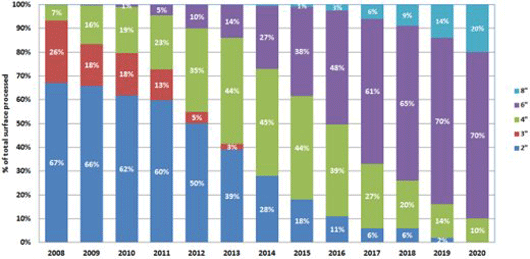- News
26 December 2011
Sapphire supply and demand back in check
 Following the massive material shortage in 2010, sapphire material and finished wafer prices remained high through early 2011, says market research firm Yole Développement in its latest ‘Sapphire Market’ report.
Following the massive material shortage in 2010, sapphire material and finished wafer prices remained high through early 2011, says market research firm Yole Développement in its latest ‘Sapphire Market’ report.
The situation was aggravated as wafer and LED manufacturers preparing for a massive intake of LEDs in the LCD TV market started building up sapphire inventory, fearing that supply might remain short. However, a softer-than-expected LED TV market and increasing sapphire capacity at established suppliers combined to rapidly bring supply and demand back into balance this summer, says Yole. This has triggered a fast drop in wafer prices that have now returned to pre-shortage levels.
While sapphire demand will pick up in late 2011 and early 2012, additional capacity from new entrants is expected to enter the supply chain and keep 2” prices at their historical lows for the foreseeable future.
Few new entrants will succeed
Coupled with significant volume growth, the sapphire material shortage experienced through 2010 and early 2011 has created a window of opportunity for new entrants. In the last 18 months, more than 50 firms have announced their intention to enter the industry. These would bring the total number of potential participants in this market to nearly 100. More than 40 of those new entrants are located in China. Looking at the mid-term, adding up the capacity plans announced by those newcomers leads to a figure corresponding to almost three times the actual demand. However, this situation is unlikely to actually materialize, reckons Yole.
Most of the new entrants have little to no prior experience in sapphire crystal growth and wafer manufacturing. While the availability of ‘turn-key solutions’ from various growth equipment suppliers has lowered the barrier to entry, reaching and sustaining high quality and high yields in sapphire crystal growth still requires significant expertise, notes Yole. The learning curve can be steep for newcomers to reach yield levels on a par with established tier-one manufacturers. Wafer finishing also requires unique expertise and could prove challenging for companies with no prior experience. In addition, beyond wire saw manufacturers offering efficient slicing solutions and process, no turnkey solution are available for wafer finishing.
 The pricing environment in 2010 was very forgiving and allowed some new entrants to achieve comfortable margins despite low yields and sub-par technology. Yole calculates that many of those new companies have production costs of $6–10 per millimeter of 2” core, and that these firms will therefore lose money at the current market price. At the same time, established vendors with higher yields, large volumes and a more favorable product mix (including large-diameter wafers) can achieve production cost below $5, which will allow them to maintain positive margins and weather the storm. Mid term, Yole expect that this situation will weed out the weakest players and trigger the withdrawal of many potential new entrants.
The pricing environment in 2010 was very forgiving and allowed some new entrants to achieve comfortable margins despite low yields and sub-par technology. Yole calculates that many of those new companies have production costs of $6–10 per millimeter of 2” core, and that these firms will therefore lose money at the current market price. At the same time, established vendors with higher yields, large volumes and a more favorable product mix (including large-diameter wafers) can achieve production cost below $5, which will allow them to maintain positive margins and weather the storm. Mid term, Yole expect that this situation will weed out the weakest players and trigger the withdrawal of many potential new entrants.
Transition to large diameters well underway
“The sapphire substrate industry, driven by LED applications, was initially developed based on a 2”-diameter platform,” says Yole’s Eric Virey. “Companies like Lumileds and Nichia were the first to move to 3” around 2003, while Osram pioneered the adoption of 4” shortly after,” he adds. “Due to the large concentration of MOCVD [metal-organic chemical vapor deposition] capacity in Taiwan, and the current ramp in China, 2” is expected to remain the dominant platform through 2012.”

Graphic (above): Diameter trends in sapphire substrates for LEDs (to 2012).
However, many established Taiwan-based epitaxy companies are transitioning from 2” to 4”, while some technology leaders in Korea, the USA and Europe have already made great strides in the their 6” conversion. Long term, a question mark remains regarding the economics of 8” sapphire, comments Yole. Nevertheless, R&D has already started and Yole believes that recent improvements in sapphire growth and slicing technologies could enable a cost of ownership that, in time, will be compatible with the adoption of the platform.
Doubling of monthly sapphire wafer demand in 2010 sends 2” price over $30s
Sapphire to exceed 50% of compound semiconductor substrate processed surface area from 2011
Sapphire faces shortage in second-half 2010, to be resolved in early 2011
